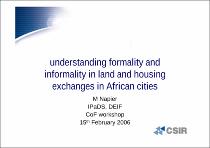 ResearchSpace
ResearchSpace
Understanding formality and informality in land and housing exchanges in African cities
JavaScript is disabled for your browser. Some features of this site may not work without it.
- ResearchSpace
- →
- Research Publications/Outputs
- →
- Conference Publications
- →
- View Item
| dc.contributor.author |
Napier, Mark

|
|
| dc.date.accessioned | 2009-01-09T14:04:01Z | |
| dc.date.available | 2009-01-09T14:04:01Z | |
| dc.date.issued | 2006-02 | |
| dc.identifier.citation | Napier, M. 2006. Understanding formality and informality in land and housing exchanges in African cities. IPaDS, DEIF CoF Workshop, CSIR, Pretoria, 15 February 2006, pp 22. | en |
| dc.identifier.uri | http://hdl.handle.net/10204/2799 | |
| dc.description.abstract | More than 60% of Africa’s urban population lives in slums and most African countries' population subsist on under US$2.0 per day, and the average probability at birth of not surviving to age 40 is about 38%. 25 to 30% of housing in SA cities is informal; the majority of land and housing transactions are unrecorded. A worldwide Millennium development goal is to significantly improve the lives of 100 million slum dwellers by 2020. It is estimated that approximately 85% of urban land parcels in developing countries and between 40% and 53% of their rural land parcels are held in such a way that they cannot be used to create capital. Suggested solutions to these problems is to extend secure tenure; formalize land markets; extend bank and formal micro-finance (indebtedness of the poor); privatization; complex, strategic decision making tools and have research based on formal information. | en |
| dc.language.iso | en | en |
| dc.subject | Informal land | en |
| dc.subject | Informal houses | en |
| dc.subject | Developing countries | en |
| dc.title | Understanding formality and informality in land and housing exchanges in African cities | en |
| dc.type | Conference Presentation | en |
| dc.identifier.apacitation | Napier, M. (2006). Understanding formality and informality in land and housing exchanges in African cities. http://hdl.handle.net/10204/2799 | en_ZA |
| dc.identifier.chicagocitation | Napier, Mark. "Understanding formality and informality in land and housing exchanges in African cities." (2006): http://hdl.handle.net/10204/2799 | en_ZA |
| dc.identifier.vancouvercitation | Napier M, Understanding formality and informality in land and housing exchanges in African cities; 2006. http://hdl.handle.net/10204/2799 . | en_ZA |
| dc.identifier.ris | TY - Conference Presentation AU - Napier, Mark AB - More than 60% of Africa’s urban population lives in slums and most African countries' population subsist on under US$2.0 per day, and the average probability at birth of not surviving to age 40 is about 38%. 25 to 30% of housing in SA cities is informal; the majority of land and housing transactions are unrecorded. A worldwide Millennium development goal is to significantly improve the lives of 100 million slum dwellers by 2020. It is estimated that approximately 85% of urban land parcels in developing countries and between 40% and 53% of their rural land parcels are held in such a way that they cannot be used to create capital. Suggested solutions to these problems is to extend secure tenure; formalize land markets; extend bank and formal micro-finance (indebtedness of the poor); privatization; complex, strategic decision making tools and have research based on formal information. DA - 2006-02 DB - ResearchSpace DP - CSIR KW - Informal land KW - Informal houses KW - Developing countries LK - https://researchspace.csir.co.za PY - 2006 T1 - Understanding formality and informality in land and housing exchanges in African cities TI - Understanding formality and informality in land and housing exchanges in African cities UR - http://hdl.handle.net/10204/2799 ER - | en_ZA |





